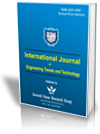Process Control in Wastewater Treatment Under Overflow Events in Saudi Arabia
Process Control in Wastewater Treatment Under Overflow Events in Saudi Arabia |
||
 |
 |
|
| © 2025 by IJETT Journal | ||
| Volume-73 Issue-10 |
||
| Year of Publication : 2025 | ||
| Author : I. M. Elshaigy, G.A. Gasmelseed, Z. A. Hamad | ||
| DOI : 10.14445/22315381/IJETT-V73I10P111 | ||
How to Cite?
I. M. Elshaigy, G.A. Gasmelseed, Z. A. Hamad,"Process Control in Wastewater Treatment Under Overflow Events in Saudi Arabia", International Journal of Engineering Trends and Technology, vol. 73, no. 10, pp.138-150, 2025. Crossref, https://doi.org/10.14445/22315381/IJETT-V73I10P111
Abstract
Wastewater treatment systems are vital to preserving human health and environmental purity. However, during overflow events caused by extreme weather, infrastructure failure, or operational abnormalities, typical treatment systems may get overwhelmed, resulting in reduced efficiency and the discharge of untreated or partially treated effluent.
Keywords
Wastewater treatment, Overflow events, Effluent quality.
References
[1] Al Aukidy M., and Verlicchi P., “Contributions of Combined Sewer Overflows and Treated Effluents to the Bacterial Load Released into a Coastal Area,” Science of the Total Environment, vol. 607, pp. 483-496, 2017.
[CrossRef] [Google Scholar] [Publisher Link]
[2] Rania Al-Tohamy et al., “A Critical Review on the Treatment of Dye-Containing Wastewater: Ecotoxicological and Health Concerns of Textile Dyes and Possible Remediation Approaches for Environmental Safety,” Ecotoxicology and Environmental Safety, vol. 231, 2022.
[CrossRef] [Google Scholar] [Publisher Link]
[3] Y. Anjaneyulu, N. Sreedhara Chary, and D. Samuel Suman Raj, “Decolourization of Industrial Effluents - Available Methods and Emerging Technologies - A Review,” Reviews in Environmental Science and Bio/Technology, vol. 4, no. 7, pp. 245-273, 2005.
[CrossRef] [Google Scholar] [Publisher Link]
[4] Tom Arnold, Jeddah Floods a Real Drain on its Economy, The National, 2011. [Online]. Available: https://www.thenationalnews.com/business/jeddah-floods-a-real-drain-on-its-economy-1.429470
[5] Ernestine Atangana, Paul J. Oberholster, and Anthony R. Turton, “RETRACTED: Will the Extraction of COVID-19 from Wastewater Help Flatten the Curve?,” Chemosphere, vol. 271, 2021.
[CrossRef] [Google Scholar] [Publisher Link]
[6] Larry D. Berefield, Joseph F. Judkins, and Barron L. Weand, Process Chemistry for Water and Wastewater Treatment, Prentice-Hall, Englewood Cliffs, 1982.
[Google Scholar]
[7] Alice Botturi et al., “Combined Sewer Overflows: A Critical Review on Best Practice and Innovative Solutions to Mitigate Impacts on Environment and Human Health,” Critical Reviews in Environmental Science and Technology, vol. 51, no. 15, pp. 1585-1618, 2021.
[CrossRef] [Google Scholar] [Publisher Link]
[8] Scott R. Burge et al., “Microbial Potentiometric Sensor: A New Approach to Longstanding Challenges,” Science of the Total Environment, vol. 742, 2020.
[CrossRef] [Google Scholar] [Publisher Link]
[9] Arturo Casal-Campos et al., “An Integrated Environmental Assessment of Green and Gray Infrastructure Strategies for Robust Decision Making,” Environmental Science & Technology, vol. 49, no. 14, pp. 8307-8314, 2015.
[CrossRef] [Google Scholar] [Publisher Link]
[10] Cox M., P. Négré, and L. Yurramendi, “Industrial Liquid Effluents,” INASMET Tecnalia, San Sebastian, 2007.
[Google Scholar]
[11] Grégorio Crini, “Recent Developments in Polysaccharide-Based Materials used as Adsorbents in Wastewater Treatment,” Progress in Polymer Science, vol. 30, pp. 38-70, 2005.
[CrossRef] [Google Scholar] [Publisher Link]
[12] Grégorio Crini, and Pierre-Marie Badot, Sorption Processes and Pollution, Presses Universitaires de Franche-Comté, Besançon, 2010.
[Google Scholar]
[13] Paolo Crocetti et al., “Catchment-Wide Validated Assessment of Combined Sewer Overflows (CSOs) in a Mediterranean Coastal Area and Possible Disinfection Methods to Mitigate Microbial Contamination,” Environmental Research, vol. 196, 2021.
[CrossRef] [Google Scholar] [Publisher Link]
[14] Maria R. C. De Sousa, Franco A. Montalto, and Sabrina Spatari, “Using Life Cycle Assessment to Evaluate Green and Grey Combined Sewer Overflow Control Strategies,” Journal of Industrial Ecology, vol. 16, no. 6, pp. 901-913, 2012.
[CrossRef] [Google Scholar] [Publisher Link]
[15] Kavya Arun Dwivedi, Song-Jeng Huang, and Chin-Tsan Wang, “Integration of Various Technology-Based Approaches for Enhancing the Performance of Microbial Fuel Cell Technology: A Review,” Chemosphere, vol. 287, 2022.
[CrossRef] [Google Scholar] [Publisher Link]
[16] Xin Fu et al., “Development of a Scenario-Based Stormwater Management Planning Support System for Reducing Combined Sewer Overflows (CSOs),” Journal of Environmental Management, vol. 236, pp. 571-580, 2019.
[CrossRef] [Google Scholar] [Publisher Link]
[17] T. Giakoumis, and N. Voulvoulis, “Combined Sewer Overflows: Relating Event Duration Monitoring Data to Wastewater Systems' Capacity in England,” Environmental Science: Water Research & Technology, vol. 9, no. 3, pp. 707-722, 2023.
[CrossRef] [Google Scholar] [Publisher Link]
[18] Emad H. Imam, and Haitham Y. Elnakar, “Design Flow Factors for Sewerage Systems in Small Arid Communities,” Journal of Advanced Research, vol. 5, no. 5, pp. 537-542, 2014.
[CrossRef] [Google Scholar] [Publisher Link]
[19] Popi Karaolia, “Evaluation of the Efficiency of the Combination of a Membrane Bioreactor with Selected Advanced Oxidation Processes for the Removal of Antibiotic-Related Microcontaminants,” Ph.D. Thesis, University of Cyprus, 2019.
[Google Scholar]
[20] S.E. Kentish, and G.W. Stevens, “Innovations in Separations Technology for the Recycling and Re-Use of Liquid Waste Streams,” Chemical Engineering Journal, vol. 84, no. 2, pp. 149-159, 2001.
[CrossRef] [Google Scholar] [Publisher Link]
[21] Moayad N. Khalaf, Green Polymers and Environmental Pollution Control, 1st ed., Apple Academic Press, Inc, CRC Press, 2016.
[Google Scholar] [Publisher Link]
[22] Zl Liao et al., “Combined Sewer Overflow Control with LID based on SWMM: An Example in Shanghai, China,” Water Science and Technology, vol. 71, no. 8, pp. 1136-1142, 2015.
[CrossRef] [Google Scholar] [Publisher Link]
[23] Camino Liquete et al., “Integrated Valuation of a Nature-Based Solution for Water Pollution Control. Highlighting Hidden Benefits,” Ecosystem Services, vol. 22, pp. 392-401, 2016.
[CrossRef] [Google Scholar] [Publisher Link]
[24] Lledó Castellet, and María Molinos-Senante, “Efficiency Assessment of Wastewater Treatment Plants: A Data Envelopment Analysis Approach Integrating Technical, Economic, and Environmental Issues,” Journal of Environmental Management, vol. 167, pp. 160-166, 2016.
[CrossRef] [Google Scholar] [Publisher Link]
[25] Cátia Magro et al., “Emerging Organic Contaminants in Wastewater: Understanding Electrochemical Reactors for Triclosan and its by-Products Degradation,” Chemosphere, vol. 247, 2020.
[CrossRef] [Google Scholar] [Publisher Link]
[26] Nadia Morin-Crini, and Grégorio Crini, Contaminated Industrial Water, University Press of Franche-Comté, 2017.
[CrossRef] [Google Scholar] [Publisher Link]
[27] Valérie Mahaut, and Hervé Andrieu, “Relative Influence of Urban-Development Strategies and Water Management on Mixed (Separated and Combined) Sewer Overflows in the Context of Climate Change and Population Growth: A Case Study in Nantes,” Sustainable Cities and Society, vol. 44, 171-182, 2019.
[CrossRef] [Google Scholar] [Publisher Link]
[28] Dennis P. Nolan, Handbook of Fire and Explosion Protection Engineering Principles: for Oil, Gas, Chemical and Related Facilities, William Andrew, 2010.
[Google Scholar] [Publisher Link]
[29] Maite Ortúzar et al., “Pharmaceutical Pollution in Aquatic Environments: A Concise Review of Environmental Impacts and Bioremediation Systems,” Frontiers in Microbiology, vol. 13, pp. 1-15, 2022.
[CrossRef] [Google Scholar] [Publisher Link]
[30] Omar K. M. Ouda, “Treated Wastewater Use in Saudi Arabia: Challenges and Initiatives,” International Journal of Water Resources Development, vol. 32, no. 5, pp. 799-809, 2016.
[CrossRef] [Google Scholar] [Publisher Link]
[31] J.W. Patterson, Industrial Wastewater Treatment Technology, OSTI.GOV, 1984.
[Google Scholar] [Publisher Link]
[32] Thitirat Petcharat et al., “Assessing Human‐Specific CrAssphage Recovery after Acidification‐Filtration Concentrating Method in Environmental Water,” Water Environment Research, vol. 92, no. 1, pp. 35-41, 2020.
[CrossRef] [Google Scholar] [Publisher Link]
[33] P.J. Phillips et al., “Combined Sewer Overflows: An Environmental Source of Hormones and Wastewater Micropollutants,” Environmental Science & Technology, vol. 46, no. 10, pp. 5336-5343, 2012.
[CrossRef] [Google Scholar] [Publisher Link]
[34] Pistocchi Alberto et al., “Water Quality in Europe: Effects of the Urban Wastewater Treatment Directive,” Publications Office of the European Union, 2023.
[CrossRef] [Google Scholar] [Publisher Link]
[35] Tanzim Ur Rahman et al., “The Advancement in Membrane Bioreactor (MBR) Technology toward Sustainable Industrial Wastewater Management,” Membranes, vol. 13, no. 2, pp. 1-28, 2023.
[CrossRef] [Google Scholar] [Publisher Link]
[36] Ashok K. Rathoure, and Vinod K. Dhatwalia, Toxicity and Waste Management Using Bioremediation, IGI Global, 2015.
[CrossRef] [Google Scholar] [Publisher Link]
[37] Eugene W. Rice et al., Standard Methods for the Examination of Water and Wastewater, 2012.
[Google Scholar] [Publisher Link]
[38] A. Rizzo et al., “Constructed Wetlands for Combined Sewer Overflow Treatment: A State-of-the-Art Review,” Science of the Total Environment, vol. 727, 2020.
[CrossRef] [Google Scholar] [Publisher Link]
[39] Christiane Schreiber et al., “Two Decades of System-Based Hygienic–Microbiological Research in Swist River Catchment (Germany),” Environmental Earth Sciences, vol. 75, no. 21, pp. 1-13, 2016.
[CrossRef] [Google Scholar] [Publisher Link]
[40] K. Schroeder et al., “Evaluation of Effectiveness of Combined Sewer Overflow Control Measures by Operational Data,” Water Science and Technology, vol. 63, no. 2, pp. 325-330, 2011.
[CrossRef] [Google Scholar] [Publisher Link]
[41] Katja Seggelke et al., “Implementation of an Integrated Real-Time Control System of Sewer System and Waste Water Treatment Plant in the City of Wilhelmshaven,” Urban Water Journal, vol. 10, no. 5, pp. 330-341, 2013.
[CrossRef] [Google Scholar] [Publisher Link]
[42] Sanjay K. Sharma, and Rashmi Sanghi, Advances in Water Treatment and Pollution Prevention, Springer, Dordrecht, 2012.
[CrossRef] [Google Scholar] [Publisher Link]
[43] Chaopeng Shen, “A Transdisciplinary Review of Deep Learning Research and its Relevance for Water Resources Scientists,” Water Resources Research, vol. 54, no. 11, pp. 8558-8593, 2018.
[CrossRef] [Google Scholar] [Publisher Link]
[44] Amit Sonune, and Rupali Ghate, “Developments in Wastewater Treatment Methods,” Desalination, vol. 167, pp. 55-63, 2004.
[CrossRef] [Google Scholar] [Publisher Link]
[45] Sara Feudo et al., “Energy Rating of a Water Pumping Station Using Multivariate Analysis,” Energy Procedia, vol. 126, pp. 385-391, 2017.
[CrossRef] [Google Scholar] [Publisher Link]
[46] Katerina Stamatelatou, and Konstantinos P. Tsagarakis, Sewage Treatment Plants: Economic Evaluation of Innovative Technologies for Energy Efficiency, IWA Publishing, 2015.
[CrossRef] [Google Scholar] [Publisher Link]
[47] Ahmed Tlili et al., “Tolerance Patterns in Stream Biofilms Link Complex Chemical Pollution to Ecological Impacts,” Environmental Science & Technology, vol. 54, no. 17, pp. 10745-10753, 2020.
[CrossRef] [Google Scholar] [Publisher Link]
[48] Katharina Tondera, “Evaluating the Performance of Constructed Wetlands for the Treatment of Combined Sewer Overflows,” Ecological Engineering, vol. 137, pp. 53-59, 2019.
[CrossRef] [Google Scholar] [Publisher Link]
[49] Katharina Tondera, Stefan Koenen, and Johannes Pinnekamp, “Survey Monitoring Results on the Reduction of Micropollutants, Bacteria, Bacteriophages and TSS in Retention Soil Filters,” Water Science and Technology, vol. 68, no. 5, pp. 1004-1012, 2013.
[CrossRef] [Google Scholar] [Publisher Link]
[50] Willy Verstraete et al., “Engineering Microbial Technologies for Environmental Sustainability: Choices to Make,” Microbial Biotechnology, vol. 15, no. 1, pp. 215-227, 2022.
[CrossRef] [Google Scholar] [Publisher Link]
[51] Philip Weyrauch et al., “Contribution of Combined Sewer Overflows to Trace Contaminant Loads in Urban Streams,” Water Research, vol. 44, no, 15, pp. 4451-4462, 2010.
[CrossRef] [Google Scholar] [Publisher Link]
[52] Noura Al-Mashaan, Kuwait: Minister Al-Mashaan and NBK Executives Review Work Progress in Shuwaikh Beach Development Project, NBK, 2019. [Online]. Available: https://www.nbk.com/kuwait/news-and-insights/media-relations/news.html?news=minister-al-mashaan-and-nbk-executives-review-work-progress-in-shuwaikh-beach-development-project
[53] Haipeng Xi et al., “Heterotrophic Nitrification and Aerobic Denitrification Process: Promising but a Long Way to Go in the Wastewater Treatment,” Science of The Total Environment, vol. 805, 2022.
[CrossRef] [Google Scholar] [Publisher Link]
[54] Dawei Yu et al., “Effect of Rainfall Characteristics on the Sewer Sediment, Hydrograph, and Pollutant Discharge of Combined Sewer Overflow,” Journal of Environmental Management, vol. 303, 2022.
[CrossRef] [Google Scholar] [Publisher Link]
[55] Feixiang Zan et al., “Food Waste-Wastewater-Energy/Resource” Nexus: Integrating Food Waste Management with Wastewater Treatment Towards Urban Sustainability,” Water Research, vol. 211, 2022.
[CrossRef] [Google Scholar] [Publisher Link]
[56] Youqin Zou et al., “Fe-Mn Binary Oxides Activated Aluminosilicate Mineral and its Tl (I) Removal by Oxidation, Precipitation and Adsorption in Aqueous,” Journal of Solid State Chemistry, vol. 303, 2021.
[CrossRef] [Google Scholar] [Publisher Link]
[57] Syahidah Nurani Zulkifli, Herlina Abdul Rahim, and Woei-Jye Lau, “Detection of Contaminants in Water Supply: A Review on State-of-the-Art Monitoring Technologies and their Applications,” Sensors and Actuators B: Chemical, vol. 255, pp. 2657-2689, 2018.
[CrossRef] [Google Scholar] [Publisher Link]

